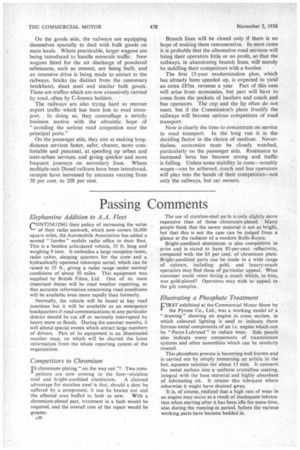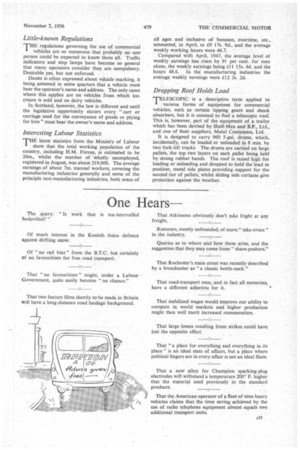Passing Comments
Page 32

Page 33

If you've noticed an error in this article please click here to report it so we can fix it.
Elephantine Addition to A.A. Fleet
CONTINUING their policy of increasing the value of their radio network, which now covers 36,000 square miles, the Automobile Association has added a second "Jumbo " mobile radio office to their fleet. This is a Seddon articulated vehicle, 33 ft. long and weighing 9 tons. It embodies a large reception room, radio cabin, sleeping quarters for the crew and a hydraulically operated telescopic aerial, which can be raised to 55 ft., giving a radio range under normal conditions of about 30 miles. This equipment was supplied by British Films, Ltd. One of its most important duties will be road weather reporting, so that accurate information concerning road conditions will be available even more rapidly than formerly.
Normally, the vehicle will be based at key road junctions but it will be available as an emergency headquarters if road communications in any particular district should be cut off or seriously interrupted by heavy snow or floods. During the summer months, it will attend special events which attract large numbers of drivers. Part of its equipment is an illuminated weather map, on which will be charted the latest information from the whole reporting system of the organization.
Competitors to Chromium
IS chromium plating "on the way out"?. Two cornpetitors are now coming to the fore—stainless steel and bright-anodized aluminium. A claimed advantage for stainless steel is that, should a dent be suffered by a component, it can be beaten out and the affected area buffed to look as new. With a chromium-plated part, treatment in a bath would be required, and the overall cost of the repair would be greater.
The use of stainless-steel parts is only slightly more expensive than of those chromium-plated. Many people think that the newer material is not as bright, but that this is not the case can be judged from a glance at the radiator of a modern Rolls-Royce.
Bright-anodized aluminium is also competitive in price and is stated to have 83-per-cent. reflectivity, compared with the 63 per cent, of chromium plate. Bright-anodized parts can be made in a wide range of colours, including gold, and luxury-coach operators may find these of particular appeal. What customer could resist hiring .a coach which, to him, was gold-plated? Operators may wish to appeal to the gilt complex.
Illustrating a Phosphate Treatment
FIRST exhibited at the Commercial Motor Show by the Pyrene Co., Ltd., was a working model of a " drawing " showing an engine in cross section, in which coloured lighting is used to indicate those ferrous-metal components of an Lc. engine which can be " Parco Lubrized " to reduce wear. Side panels also indicate many components of transmission systems and other assemblies which can be similarly treated.
This phosphate process is becoming well known and is carried out by simply immersing an article in the hot, aqueous solution for about 15 min. It converts the metal surface into a uniform crystalline coating, integral with the base material and highly absorbent of lubricating oil. It retains this lubricant where otherwise it might have drained 4way.
It is, of course, realized thata high rate of wear in an engine may occur as a result of inadequate lubrication when starting after it has been idle for some time, also during the running-in period, before the various working parts have become bedded in.
Little-known Regulations
THE regulations governing the use of commercial vehicles are so numerous that probably no one person could be expected to know them all. Traffic indicators and stop lamps have become so general that many operators consider they are compulsory. Desirable yes, but not enforced.
Doubt is often expressed about vehicle marking, it being assumed in some quarters that a vehicle must bear the operator's name and address. The only cases where this applies are on vehicles from which icecream is sold and on dairy vehicles.
In Scotland, however, the law is different and until the legislative opportunity occurs every "cart or carriage used for the conveyance of goods or plying for hire" must bear the owner's name and address.
Interesting Labour Statistics
THE latest statistics from the Ministry of Labour 'THE that the total working population of the country, including H.M.• Forces, is estimated to be 24m., whilst the number of wholly unemployed, registered in August, was about 219,000. The average earnings of about 7m. manual workers, covering the manufacturing industries generally and some of the principle non-manufacturing industries, both sexes of all ages and inclusive of bonuses, overtime, etc., amounted, in April, to £9 17s. 9d., and the average weekly working hours were 46.7.
Compared with April, 1947, the average level of weekly earnings has risen by 91 per cent. for men alone, the weekly earnings being El 1 15s. 4d. and the hours 48.6. In the manufacturing industries the average weekly earnings were £12 2s. 2d.
Dropping Roof Holds Load
TELESCOPIC is a descriptive term applied to various forms of equipment for commercial vehicles, such as certain tipping gears and shock absorbers, but it is unusual to find a telescopic roof. This is, however, part of the equipment of a trailer which has been devised by Shell-Mex and B.F., Ltd., and one of their suppliers, Metal Containers, Ltd.
It is designed to carry 960 5-gal. drums, which, incidentally, can be loaded or unloaded in 8 min. by two fork-lift trucks. The drums are carried on large pallets, the top two layers on each pallet being held by strong rubber bands. The roof is raised high for loading or unloading and dropped to hold the load in position, metal side plates providing support for the second tier of pallets, whilst sliding side curtains give protection against the weather.
















































































































